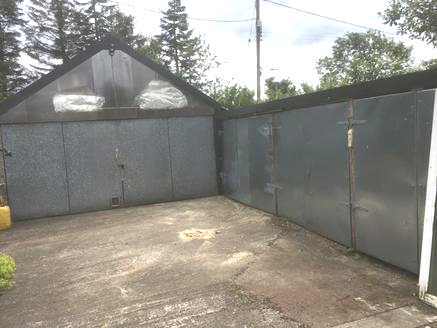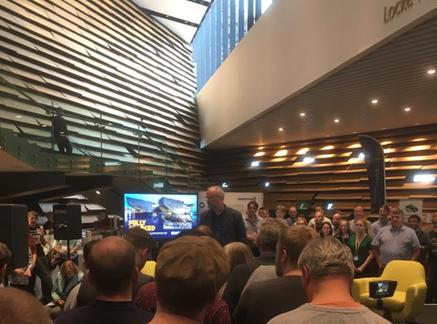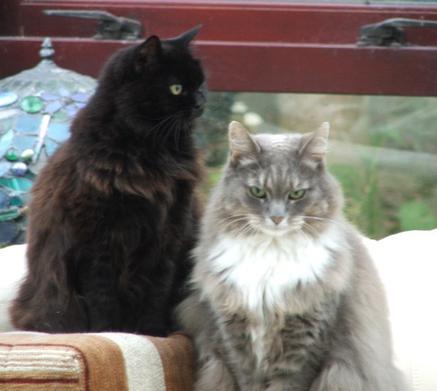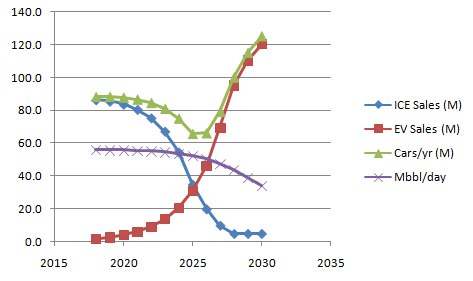26/09/2019
Sad news to start with, Errol the cat is no longer with us. We had to take him to the vet as he'd started suffering the effects of age, and apart from the occasional 'accident' endangering the carpets he was having difficulty getting comfortable and tended to just sit in front of his water bowl looking unhappy. An anthropomorphism I know, but we could tell he wasn't enjoying life unless he was asleep in full sun in the porch. The approaching winter didn't bode well.
At the end it was quite peaceful and he was treated well by the vet. He never liked going to the vet, mainly because of the carrying box I think but although he grizzled a bit on the way he was quite relaxed there and I think we were more upset than he was. A very polite cat of considerable intelligence and character. Here he is in 2015 with Maggie.
Otherwise we are doing well here, the weather has been generally good although occasionally surprisingly extreme. The term four seasons in one day really doesn't do it justice. More like an hour sometimes.
Although it has been very sunny, very wet and very windy in turn it hasn't stopped me to getting on with a few bits of construction, the latest being some garage doors. High winds can make a sheet of 8x4 foot galvanised steel quite interesting. You’ll just about see from the photo that I’ve made some progress putting a new door in the corner now the caravan has moved on. The caravan was 6" too long to put doors across the front of it. They are just raw galvanised steel, so I'll have to paint them sooner or later, although the first ones aren't and they've been up a few years now.
The new garage doors are constructed with my standard method of galvanised steel on a home made wooden frame with farm gate hinges. I had to make one part a bi-fold experiment, it seems to work now I’ve reversed the hinge on the middle one. I had tried it opening inward but it was too restrictive of the space inside.
The caravan didn’t fetch as much as I’d hoped, but I guess the value is simply what somebody will pay. I did think of holding out for another thousand, but interest was limited and there’s no point in waiting as it aged, unused and taking up space. The process wasn't made any easier by people making an offer and then changing their minds. I had considered keeping it until I found out if the electric car could tow it, but other EV owners have said the range is severely reduced, and there's not much point in camping 50 miles from home.
The caravan space was filled quite quickly with wasps. Well not actually filled, but they got in the way. Every season has variations, sometimes it’s good for berries, sometimes butterflies. This summer seems to have been good for wasps. I haven’t been stung, but I’ve had three or four nests appear in the (ex-caravan) shed and one in the house. I hadn’t realised that they start off with a nest the size of a golf ball and, while using it they deconstruct some of the inside, take the material outside and make it bigger. I hadn’t really thought about it until now. Initial activity is quite low and they are quite unobtrusive so several small nests were demolished accidentally. They like building in the garage ceiling where I keep long things like pipes and spare guttering, but when I eventually noticed a growing nest I avoided damaging it. The question was how long would it go on growing? Now solved as they seem to have left. They weren’t too happy with my new doors on the caravan shed, but seemed to have got used to flying through the gaps. The porch, where the second batch of wasps were living, needed adjusting as they had found an entrance next to the thermostatic opening window.
I use green-house window openers to vent areas that get too hot. Normally they could fly in and out at will, but when it cools suddenly the window closes and traps a few inside. They started turning up in the house so I had to make them a new access point and close up the old one. They seemed to have adapted and again seemed to lose interest in the site as the weather cooled. I’ve made it less attractive for next year, by bunging up the entrance. I try to work on a live and let live principle but they fly around at head height and don’t really understand who has right of way. Both species are averse to random diversions.
I had thought that the cedar planking would repel them, as I was told that the wood was used in biblical times as a defence against termites but they seem to be quite happy and may even prefer it to treated wood. So much for biblical DIY suggestions.
As part of a ‘getting used to the electric car’ exercise we drove over the new bridge, Queensferry Crossing, to Dundee via Montrose for lunch, and to see the ’Fully Charged Show’ with Robert Llewellyn. Parts of Scotland and Dundee in particular have a quite advanced charging infrastructure, which makes life easier, and some of the electricity is free or discounted as is the parking for EVs. Our return journey looked a bit long for the charge on board so we stopped at a motorway coffee shop and picked up a recharge from an ecotricity ‘pump’. As they are our home electricity suppliers it was half price (13p per kWh totalling £3.43 for about 120 miles) and the coffee was good, though I’ll have to get some re-usable coffee cups as the motorway ones are always non recyclable. The recharge took about 35 minutes, but we spent rather longer chatting to another EV driver who had been at the show. The much reported range anxiety had made a slight appearance on the way in, as we discovered the car’s built-in map was rather vague and we couldn’t find a particular university campus charger, but the various phone apps covered the deficiency and I realised it was just a matter of a bit more planning. We rarely need to charge away from home, perhaps once every other month or so when we go further than usual. Eventually I hope to get a smarter system so I can buy electricity cheap and even sell it back to the grid at a profit, or run the house on it and aim for self sufficiency.
Of course with the number of rapid changes like EVs, solar panels and the like I think I’ve had a reasonable shot at being able to ride out the transitional period. Being an ‘early adopter’ means the system isn’t fully ready, but it never would be until there are enough of us. Tesla has invested hugely in a dedicated system but they aren't cheap and don’t do a van / taxi version yet.
On the conventional car side, I have the MX5, which means I can fall back on petrol if I want to go far and fast but for now it is just for fun.
There are going to be a lot of changes in the near future, and Brexit is only the start of it, assuming it eventually gets forced through. The oil companies don’t seem to have changed direction at all and is still investing 1% in EV work and 99% in new oil wells. The car making industry has shifted a bit, but I think there will be quite a shock as soon as electric cars equal Internal Combustion range, they are already cheaper to buy and run over 3 - 5 years. When that point is recognised by the individual car buyer everything changes. One factor as yet unobserved I think, is that many of these businesses, large and small, will have to close or change when their predicted profits fall off the cliff. Garages, filling stations and factories will be challenged as demand falls. So although the curves seem smooth the individual companies will stop quite suddenly. Worth considering if you are employed in one of them. Many will be able to re-invent, petrol stations will become recharging stations and mechanics will either become ICE / EV conversion shops for classic cars or in a few cases will maintain cherished petrol cars in the same way as (in the UK) steam trains are preserved with signal tracks and stations. I think there'll be a lot of demand for 'off the shelf' conversion kits and they'll get considerably cheaper as the battery supply fills out. Mostly however there's going to be one heck of an unemployment or retraining jump and most of the new jobs are going to be software / robotic. Generally industry doesn't care much about employees once they become surplus, and consumers rarely care where the product comes from. I doubt they're going to start now, look at Chicago. When self driving cars and trucks arrive there are going to be unemployed Taxi drivers, bus drivers and similar thrown into the mix. Now might be a good time to start looking at some fundamentals like your government's attitude toward social security and considering a guaranteed income, what population you need and who's going to be in charge. Russia's income is largely fossil fuel based. What are they going to do when the cash stops?
On that thought line, the middle east is probably just going to shift to solar power. Desert countries should do well.
There’s a couple of Americans talking about graphs here https://www.youtube.com/watch?v=aUC6lsLr04I which might be of interest, although the presentation may be a little simplified for the hard of thinking, and I’m not too sure about the maths behind the Y axis.
The article in question is at
and while I don’t doubt there will be ifs, ands and buts I think the author has a point. The industrial revolution wasn't over-night, but things move faster now.
My camera seems to have suffered a stroke, or something, and although it can still take photos it gets upset if I take two. On the left is an image of the lifting desk (better for my back) and below is what happens if I do it again. Fairly weird I think you'll agree - and the third photo comes out even worse. So I've resurrected My Uncle Tom's old Olympus, which after I had done a little repair work seems to be fine. The resolution isn't as high, but perfectly OK for what I do. I noted the price of a new Panasonic DMCTZ2 or rather the price of a new equivalent, something like £500 ! so I think I'll check out the 'second hand but newer' prices. Stuff goes out of date so fast now I can keep up and stay just one or two generations behind, and of course by the time I get near a piece of kit the experts have been using them for years and know if they are any good.
Well that's me up to date on most of it, I hope to get a tow-bar shortly so I can shift small trailer loads of wood for the village elderly or infirm. Most people have wood burning stoves if they can so that long term power-cuts aren't a problem. They haven't happened nearly as often as they used to, but there is a natural caution if you live out in the country. I do have a petrol generator, three in fact, but I would hate to have to recharge the car with it. Unlikely though, serious power-cuts usually only happen in deep snow situations, when the electric engineers can't get to the problem, so I wouldn't be going anywhere anyway. This on the left was the last significant fall, and because we are quite sheltered it was easy to deal with. It's when it drifts that we get stuck. Global warming seems to have reduced the chances of similar for now, but if we get a stalled jet stream at just the wrong time it could prove interesting. For that reason we have a good food stock, wood, insulation, plenty of whisky, (for purely medicinal purposes) and lots of books.
ICE sales (in blue) down 20% ~2021 and approach 0 ~2027
EV sales (in red) reach 20% ~2024 and pass 90M ~2028
ICE plus EV sales (in green) show a 35% decline in new auto sales around 2025. Some assumptions sets I made showed new cars sold dropping by 55% in 2025 for one year. The dip shown is a "best case" scenario for new car sales and assumes a rapid growth in EV production capacity.
Transportation Oil Demand (in purple) indicates a glut will form around 2023 with >2Mbbl/day demand displaced by the global EV fleet.






